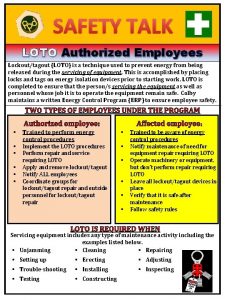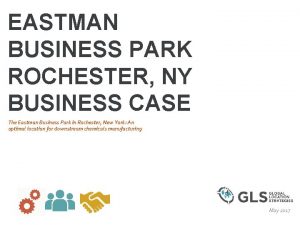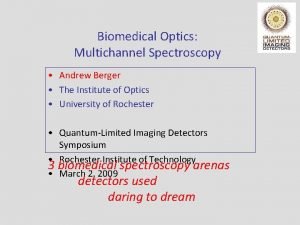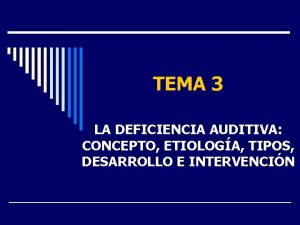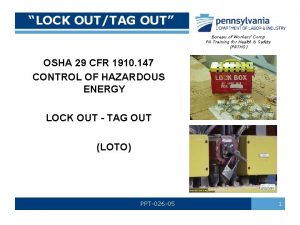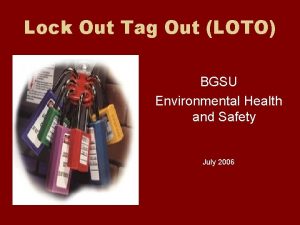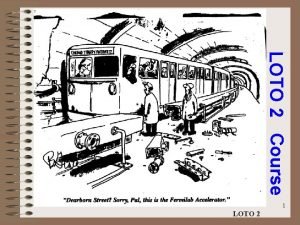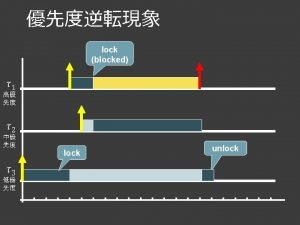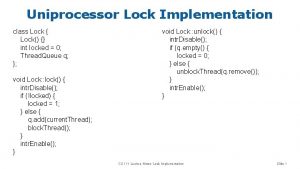Lock OutTag Out LOTO Rochester Institute of Technology


























- Slides: 26

Lock Out/Tag Out (LO/TO) Rochester Institute of Technology 1

This material was produced under grant number 46 B 4 -HT 15 from the Occupational Safety and Health Administration, U. S. Department of Labor. It does not necessarily reflect the views or policies of the U. S. Department of Labor, nor does mention of trade names, commercial products, or organizations imply endorsement by the U. S. Government. Rochester Institute of Technology 2

LOCK OUT / TAG OUT (LO/TO) 29 CFR 1910. 147 "Lockout/tagout" refers to specific practices and procedures to safeguard employees from the unexpected energization or startup of machinery and equipment, or the release of hazardous energy during service or maintenance activities. 3

LO/TO v Most incidents occur in workplace around machinery or equipment v Other incidents occur from electric shock or hazardous materials v This can be avoided by using Lock Out/Tag Out to contain hazardous energy Rochester Institute of Technology 4

LO/TO When To Use It • For Service & ü ü ü Maintenance of Equipment Installation Inspection Cleaning Modification Lubrication Un-jamming Rochester Institute of Technology • If worker needs to remove safety guards • When a worker needs to place any part of their body into machinery • To avoid an unexpected start-up 5

LO/TO Energy Sources v Electrical v Hydraulic & pneumatic v Potential energy from springs v Gravity v Chemical v Radiation v Pneumatic v Thermal v Mechanical (from sources other than springs) Rochester Institute of Technology 6

LO/TO Achieve Zero Energy Status v Utilizing Lock Out/Tag Out v No one may start the machinery or equipment while it is being repaired or cleaned Rochester Institute of Technology 7

LO/TO Three Classifications v Authorized Personnel: perform service and maintenance, apply locks & tags v Affected Personnel: operate the machinery, prepare machines and/or equipment, and work within same area when lock out/ tag out occurs v Other: may pass by an area where LO/TO is being used (example: an office worker) Rochester Institute of Technology 8

LO/TO Lock Out Devices v Lock with one key and a tag v Chain v Block v Flange v Pipe blank or blind Rochester Institute of Technology 9

LO/TO Tag Out Devices v Tags are always attached to the lock or energy isolation device v Serves as a communication device v TAG STATES: DO NOT OPERATE and securely fastened Rochester Institute of Technology 10

LO/TO v Locks and Tags are to be used by each individual working on a machine (double check for extraneous power or stored energy), either on the hasp itself, or lockable to a box with alternate hasp – should only be removed by the individual, after work is complete or replaced by oncoming shift v Tags without locks only allowed when as safe as lock and additional protection is taken – i. e. cap over start button with fuse removed in panel Rochester Institute of Technology 11

Lock & Tag with equipment lock Rochester Institute of Technology 12

Lock & Tag with personal tag Rochester Institute of Technology 13

LO/TO Six Steps of LO/TO 1. Preparation 2. Equipment Shutdown 3. Equipment Isolation 4. Application of LO/TO device 5. Release of stored energy 6. Verification Rochester Institute of Technology 14

LO/TO Six Steps of LO/TO (cont’d) 1. Preparation: identify and isolate hazardous 2. 3. energy sources, and understand how to use equipment Equipment Shutdown: stop buttons, and follow shut down procedures Equipment Isolation: install device to isolate hazardous energy sources Rochester Institute of Technology 15

LO/TO Six Steps of LO/TO (cont’d) 4. Apply Locks & Tags: if something can be locked, it MUST be locked; if it can’t be locked it MUST be tagged 5. Release Stored Energy: guard against residual energy 6. Verification: try activating start button to ensure everything is off, check interlock, and be sure area is clear Rochester Institute of Technology 16

LO/TO When Work is Complete v Remove tools & equipment v Keep a safe distance v Remove LO/TO devices v Restore energy v Notify operators and supervisors work is complete Rochester Institute of Technology 17

LO/TO Doesn’t Apply When… v Performing routine adjustments v Performing repetitive adjustments v Working on cord & plug equipment kept within sight v Integral with production Always use safe work practices Rochester Institute of Technology 18

LO/TO Employee Training v Employer must provide initial training and retraining as necessary v Training must be certified with employee’s name and date of training Rochester Institute of Technology 19

LO/TO Written Procedures v Routine lockouts require the company to maintain a written procedure for: – Each individual machine or piece of equipment, or – Each group of similar machines or equipment v Non-routine lockouts must have a specific written procedure for the lockout activity. Rochester Institute of Technology 20

LO/TO Written Procedures must have: 1. A statement of the intended use of the procedure 2. Procedural steps for the LOTO process for that type of equipment. Specific steps for testing a machine to determine if a “zero energy” state is achieved 3. Steps to release or remove the equipment from LOTO Rochester Institute of Technology 21

LO/TO Periodic Inspections v Performed at least annually to assure that the energy control procedures are effective and continue to be implemented v Inspection must be certified; identify machinery and equipment, record the date, and note employees included in the inspection v Review with all authorized users Rochester Institute of Technology 22

LO/TO Tag-Only Situations v When machine or equipment cannot be locked out v Employer may choose to modify to allow 100% LO/TO v Full protection includes complying with all Tag Out provisions, plus implementing additional safety measures Rochester Institute of Technology 23

LO/TO Group LO/TO v Group LO/TO includes having each authorized employee place his/her lock and tag on equipment being locked out – See www. osha. gov/dts/osta/lototraining/tutorial/gr-loto. htm for examples of group procedures v Shift or Personnel Change – specific procedures are utilized during shift changes Rochester Institute of Technology 24

LO/TO Absentee Lock Removal v One person at the company is designated This designated person must: v Make reasonable efforts to find the absentee individual v Ensure it is safe to remove the device v Absent Authorized Individual must be notified BEFORE resuming work at the facility. Rochester Institute of Technology 25

LO/TO Summary v LO/TO provides for control of energy sources that could cause injury during service or maintenance of machinery and equipment v Devices must be unique and substantial v Authorized Individuals are the ONLY people who can apply locks, tags and other LO/TO devices v Tags must identify who applied the device v Six steps must be followed. v Written procedures must be developed v Group lockouts and Absentee lock removal processes defined Rochester Institute of Technology 26
 Loto safety talk
Loto safety talk Lock out tag out pictures
Lock out tag out pictures Loto kombinacije program
Loto kombinacije program Loto u
Loto u Figurative language in one direction songs
Figurative language in one direction songs Dr. fernando cosio rochester mn
Dr. fernando cosio rochester mn Edra rochester
Edra rochester Lattimore hall
Lattimore hall Criterios de rochester sap
Criterios de rochester sap Mbhs moodle
Mbhs moodle Eastman business park
Eastman business park Csc 282 rochester
Csc 282 rochester Rochester first time home buyer
Rochester first time home buyer çağrı safa buyurgan
çağrı safa buyurgan çağrı safa buyurgan
çağrı safa buyurgan Rochester kriterleri
Rochester kriterleri University of rochester care network
University of rochester care network Rochester golf carts
Rochester golf carts Csc 161 rochester
Csc 161 rochester Andrew berger rochester
Andrew berger rochester The rochester cloak
The rochester cloak Martin rochester
Martin rochester Rochester and rutherford hall
Rochester and rutherford hall Minneapolis preschool screening instrument-revised (mpsi-r)
Minneapolis preschool screening instrument-revised (mpsi-r) Desco industries sanford nc
Desco industries sanford nc Método rochester
Método rochester Criterios de rochester
Criterios de rochester
